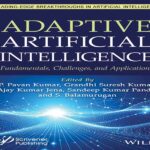- عنوان کتاب: Adaptive Artificial Intelligence
- نویسنده: P. Pavan Kumar
- حوزه: مبانی هوش مصنوعی
- سال انتشار: 2025
- تعداد صفحه: 550
- زبان اصلی: انگلیسی
- نوع فایل: pdf
- حجم فایل: 26.0 مگابایت
این کتاب به بررسی مرز بعدی در هوش مصنوعی و سیستمهایی میپردازد که قادر به یادگیری و سازگاری خودکار در محیطهای پویا و پیچیده هستند. این کتاب با مروری جامع بر هوش مصنوعی سنتی آغاز میشود و چگونگی عملکرد چنین سیستمهایی را در پارامترهای از پیش تعیینشده و محدودیتهای آنها در سناریوهای دنیای واقعی که نیاز به تنظیم مداوم دارند، بررسی میکند. این بخش بنیادی، بر نیاز به سیستمهای هوش مصنوعی که نه تنها وظایف را بر اساس مدلهای ایستا اجرا میکنند، بلکه با دادهها و تجربیات جدید تکامل مییابند و انعطافپذیری و اثربخشی بیشتری را در زمینههای غیرقابل پیشبینی فراهم میکنند، تأکید میکند. قلب کتاب بر مکانیسمهایی تمرکز دارد که رفتار تطبیقی در هوش مصنوعی را تقویت میکنند. این کتاب تکنیکهای یادگیری ماشین مانند یادگیری تقویتی، یادگیری انتقالی و یادگیری مداوم را بررسی میکند – روشهایی که به سیستمها اجازه میدهند اقدامات خود را در طول زمان کنترل کنند. نقش حلقههای بازخورد به تفصیل مورد بحث قرار گرفته و نشان میدهد که چگونه ورودیهای بلادرنگ به سیستمهای هوش مصنوعی کمک میکنند تا به طور مداوم تنظیم و بهبود یابند. این کتاب همچنین به ادغام هوش مصنوعی تطبیقی با فناوریهای نوظهور مانند اینترنت اشیا (IoT) و محاسبات لبهای میپردازد که دامنه هوش مصنوعی را در محیطهای غیرمتمرکز و با منابع محدود گسترش میدهند. این کتاب در بخشهای ابتدایی خود، کاربردهای دنیای واقعی را در بخشهایی از جمله مراقبتهای بهداشتی، مالی، وسایل نقلیه خودران و شهرهای هوشمند بررسی میکند – حوزههایی که هوش مصنوعی تطبیقی در حال حاضر تأثیر قابل اندازهگیری دارد. همچنین به چالشهای اخلاقی مانند شفافیت، پاسخگویی و انصاف میپردازد و نگاهی متفکرانه به مسئولیتهایی که با استقرار سیستمهای هوشمند و در حال تکامل همراه است، به خوانندگان ارائه میدهد. هوش مصنوعی تطبیقی نشان دهنده پیشرفت بزرگی در تکامل هوش مصنوعی است، به ویژه برای صنایعی که به فناوریهای قوی، انعطافپذیر و پاسخگو نیاز دارند. برخلاف مدلهای سنتی که به قوانین ثابت و دادههای ایستا متکی هستند، هوش مصنوعی تطبیقی در زمان واقعی تکامل مییابد – و آن را در محیطهایی که شرایط به سرعت و غیرقابل پیشبینی تغییر میکنند، ضروری میسازد. هوش مصنوعی تطبیقی با فعال کردن سیستمها برای بهبود خودکار، نوآوری را در صنایع هدایت میکند. این امر کارایی را افزایش میدهد، زمان از کارافتادگی را کاهش میدهد و تصمیمگیری را تیزتر میکند. به عنوان مثال، در تولید، سیستمهای تطبیقی میتوانند از دادههای تجهیزات برای بهینهسازی فرآیندها در زمان واقعی یاد بگیرند. در امور مالی، آنها میتوانند با روندها و نوسانات بازار سازگار شوند تا استراتژیهای سرمایهگذاری را کنترل کنند. از آنجایی که صنایع به طور فزایندهای برای عملکردهای حیاتی خود به هوش مصنوعی متکی هستند، سازگاری به سنگ بنای اتوماسیون، تابآوری و عملکرد هوشمند تبدیل میشود. این کتاب شامل شانزده فصل است که توسط نویسندگان برجسته نوشته شده است. فصل 1 به بررسی چگونگی بهبود نتایج پزشکی توسط هوش مصنوعی تطبیقی با پردازش مجموعه دادههای گسترده، پشتیبانی از تشخیصهای پیشبینیکننده و افزایش مراقبتهای مبتنی بر شواهد میپردازد. همچنین بررسی میکند که چگونه اتوماسیون میتواند حجم کار پزشکان را کاهش دهد و زمان بیشتری را برای موارد پیچیده فراهم کند. فصل 2 تأثیر واقعی یادگیری انتقالی را در زمینههایی مانند بینایی کامپیوتر، رباتیک و مراقبتهای بهداشتی بررسی میکند. مطالعات موردی از Netlix، Tesla و تشخیص COVID-19 نشان میدهد که چگونه سیستمهای تطبیقی راهحلها را با دادههای محدود شخصیسازی میکنند. جهتگیریهای آینده شامل یادگیری مادامالعمر، هوش مصنوعی قابل توضیح و محاسبات لبهای است. فصل 3 چارچوبی یکپارچه برای بهکارگیری هوش مصنوعی تطبیقی در تابآوری اقلیمی ارائه میدهد که شامل روشهای متنوع و دیدگاههای ذینفعان برای طراحی سیستمهای پاسخگو است که به تهدیدات زیستمحیطی میپردازند. فصل 4 بر هوش مصنوعی تطبیقی در پردازش زبان طبیعی (NLP) تمرکز دارد، با تأکید بر چالشهای اخلاقی توسعه هوش مصنوعی مسئولانه در سیستمهای مبتنی بر زبان. فصل ۵ به بحث در مورد ادغام یادگیری ماشین با شبکهسازی نرمافزارمحور (SDN) میپردازد و پروتکلها، توپولوژیها، الگوریتمهای مسیریابی و تصمیمگیری مبتنی بر هوش مصنوعی را با استفاده از تکنیکهایی مانند SVM، شبکههای عصبی و خوشهبندی پوشش میدهد. فصل ۶ یک مدل محاسبات نرم جدید برای پیشبینی ارزش خالص داراییها معرفی میکند. شبیهسازیهای مقایسهای با دادههای دنیای واقعی، عملکرد برتر را در مقایسه با سایر رویکردهای محاسبات نرم نشان میدهند. فصل ۷ نقش یادگیری تقویتی را در بهینهسازی شبکه تجزیه و تحلیل میکند. مطالعات موردی، پتانسیل آن را برای افزایش عملکرد شبکه تطبیقی، کارآمد و انعطافپذیر برجسته میکند. فصل ۸ پتانسیل هوش مصنوعی تطبیقی را برای تبدیل سیستمهای اتوماسیون از طریق بهبود مقیاسپذیری و تابآوری بررسی میکند. همچنین به کیفیت دادهها، شفافیت و چالشهای هزینه میپردازد. فصل ۹ هوش مصنوعی تطبیقی را در سیستمهای بلادرنگ، از جمله پردازش دادهها، محاسبات لبه، ادغام اینترنت اشیا و راهحلهای هوشمند، با نگاهی به محدودیتهای فعلی و روندهای آینده پوشش میدهد. فصل ۱۰ جزئیات چگونگی افزایش بهرهوری در عملیات استخراج زغال سنگ را شرح میدهد. این فصل استراتژیهایی را برای بهبود مشارکت نیروی کار و دستیابی به نتایج پایدار تشریح میکند. فصل ۱۱، ابتکارات شهر هوشمند ژاپن را تجزیه و تحلیل میکند، به ویژه اینکه چگونه برنامههای آزمایشی تحت حمایت دولت با تلاشهای پایداری جهانی مانند پروتکل کیوتو همسو میشوند. فصل ۱۲ پتانسیل هوش مصنوعی در سرطانشناسی را برجسته میکند و نشان میدهد که چگونه ترکیب زیستشناسی و هوش مصنوعی میتواند از … پشتیبانی کند…
This book explores the next frontier in AI and the systems capable of learning and adapting autonomously in dynamic, complex environments. It begins with a comprehensive overview of traditional AI, examining how such systems operate within predeined parameters and their limitations in real-world scenarios that demand ongoing adjustment. This foundational section underscores the need for AI systems that not only execute tasks based on static models but also evolve with new data and experiences, enabling greater resilience and effectiveness in unpredictable contexts. The heart of the book focuses on the mechanisms that empower adaptive behavior in AI. It explores machine learning techniques such as reinforcement learning, transfer learning, and continuous learning— methods that allow systems to reine their actions over time. The role of feedback loops is discussed in detail, highlighting how real-time inputs help AI systems adjust and improve continuously. The book also addresses the integration of adaptive AI with emerging technologies like the Internet of Things (IoT) and edge computing, which expand AI’s reach in decentralized, resource-constrained environments. In its inal sections, the book examines real-world applications across sectors including healthcare, inance, autonomous vehicles, and smart cities —ields where adaptive AI is already making a measurable impact. It also tackles ethical challenges such as transparency, accountability, and fairness, offering readers a thoughtful look at the responsibilities that come with deploying intelligent, evolving systems. Adaptive Artiicial Intelligence represents a major advancement in the evolution of AI, particularly for industries that require robust, lexible, and responsive technologies. Unlike traditional models, which rely on ixed rules and static data, adaptive AI evolves in real time—making it indispensable in environments where conditions shift rapidly and unpredictably. By enabling systems to improve autonomously, Adaptive AI drives innovation across industries. It enhances eficiency, reduces downtime, and sharpens decision-making. In manufacturing, for example, adaptive systems can learn from equipment data to optimize processes in real time. In inance, they can adjust to market trends and volatility to reine investment strategies. As industries increasingly rely on AI for mission- critical functions, adaptability becomes a cornerstone of automation, resilience, and intelligent performance. This book contains sixteen chapters contributed by accomplished writers. Chapter 1 explores how Adaptive AI improves medical outcomes by processing vast datasets, supporting predictive diagnostics, and enhancing evidence-based care. It also considers how automation can reduce clinician workload, enabling more time for complex cases. Chapter 2 examines the real-world impact of transfer learning in ields such as computer vision, robotics, and healthcare. Case studies from Netlix, Tesla, and COVID-19 diagnostics illustrate how adaptive systems personalize solutions with limited data. Future directions include lifelong learning, explainable AI, and edge computing. Chapter 3 presents an integrated framework for applying Adaptive AI to climate resilience, incorporating diverse methods and stakeholder perspectives to design responsive systems that address environmental threats. Chapter 4 focuses on Adaptive AI in natural language processing (NLP), with emphasis on the ethical challenges of responsible AI development in language-based systems. Chapter 5 discusses the integration of machine learning with Software Deined Networking (SDN), covering protocols, topologies, routing algorithms, and AI-based decision-making using techniques such as SVM, neural networks, and clustering. Chapter 6 introduces a novel soft computing model for forecasting net asset values. Comparative simulations with real-world data show superior performance against other soft computing approaches. Chapter 7 analyzes the role of reinforcement learning in network optimization. Case studies highlight its potential to enhance adaptive, eficient, and lexible network performance. Chapter 8 explores Adaptive AI’s potential to transform automation systems through improved scalability and resilience. It also addresses data quality, transparency, and cost challenges. Chapter 9 covers Adaptive AI in real-time systems, including data processing, edge computing, IoT integration, and smart solutions, with a look at current limitations and future trends. Chapter 10 details how understanding human behavior can boost productivity in coal mining operations. The chapter outlines strategies to improve workforce engagement and achieve sustainable outcomes. Chapter 11 analyzes Japan’s smart city initiatives, particularly how government-supported pilot programs align with global sustainability efforts like the Kyoto Protocol. Chapter 12 highlights AI’s potential in oncology, showing how combining biology and AI can support precise, personalized cancer treatment in future healthcare systems. Chapter 13 reviews the beneits of cloud manufacturing in healthcare, including cost-effectiveness, eficiency, and customization. Challenges and future trends are also discussed. Chapter 14 describes a GAN-based encryption technique for securing electronic health records. The model adds differential privacy via Laplacian noise and demonstrates strong performance in maintaining data security and recoverability. Chapter 15 presents a multi-stage neural network architecture for high- performance big data pre-processing. The system addresses data cleaning, selection, upgrading, and reinement across heterogeneous data types. Chapter 16 contributes to the discourse on sustainable inance and responsible AI, with practical insights for institutions aiming to integrate ESG analysis using advanced technologies. The chapter also highlights the link between education and sustainability in inancial decision-making. Each chapter offers a fresh perspective on how Adaptive AI is being developed, tested, and deployed in critical areas. As editors, we’ve aimed to capture the latest trends, innovations, and ethical debates in the ield. This book is designed to serve as a reference for system architects, developers, researchers, and practitioners who seek to understand or implement adaptive, intelligent systems.
این کتاب را میتوانید از لینک زیر بصورت رایگان دانلود کنید:
Download: Adaptive Artificial Intelligence




































نظرات کاربران